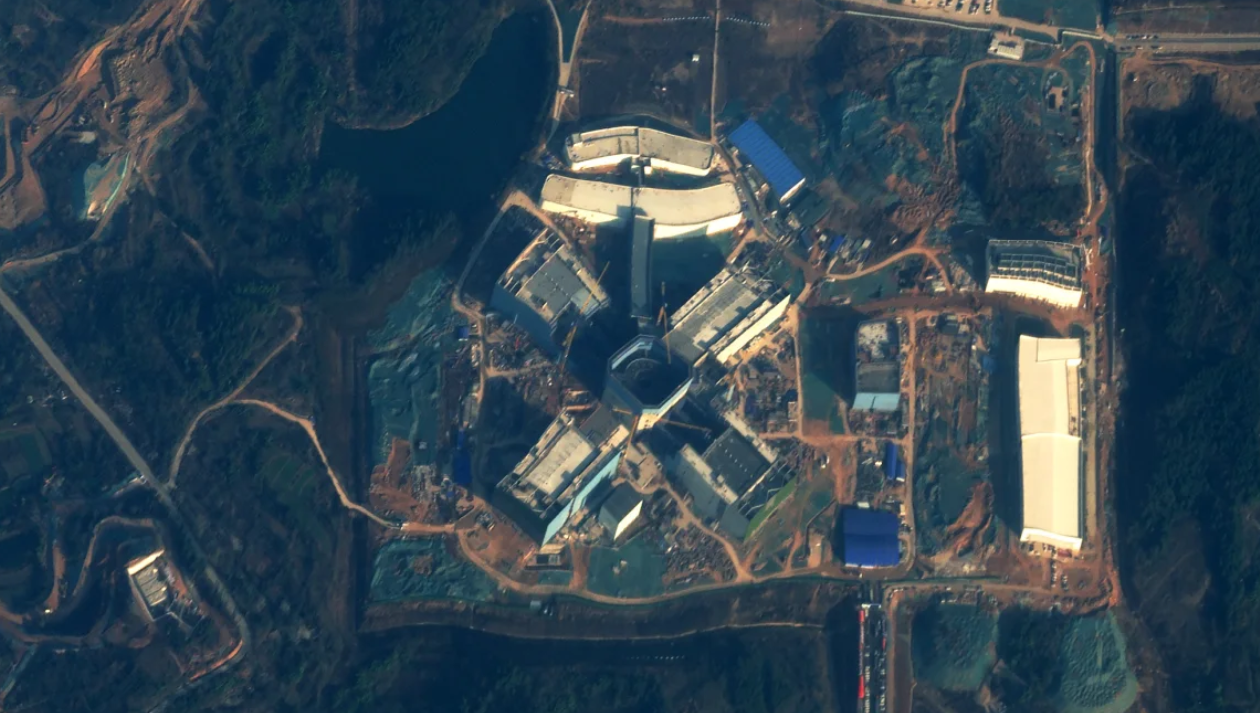Satellite images have revealed a massive X-shaped structure emerging from the rocky landscape in southwestern China, which analysts believe is a large nuclear fusion research facility. This facility could be a sign that China is making significant strides in the pursuit of nuclear fusion energy. However, the development also raises concerns about potential connections to nuclear weapons production.
Decker Eveleth, an analyst with the US-based research organization CNA Corporation, has been tracking this site for years. In 2020, a US official shared satellite images indicating possible Chinese nuclear sites, including one near Mianyang in Sichuan province. At that time, the site was just an empty patch of land, but construction has rapidly advanced since the Covid-related shutdowns ended. The project is referred to as a “laser fusion” facility in contract documents Eveleth reviewed.
If it is indeed a laser fusion facility, it would provide a unique way to study materials under extreme conditions. It enables scientists to recreate the immense pressures found at the centers of stars or inside nuclear weapons, as explained by Brian Appelbe, a research fellow from Imperial College London’s Centre for Inertial Fusion Studies.
According to Eveleth, the satellite images show four large arms, or “bays,” which are designed to fire lasers at a central tower containing a target chamber with hydrogen isotopes. The laser energy fuses the hydrogen, producing a burst of energy, a process known as ignition.
Nuclear fusion holds the promise of abundant, clean energy without the long-term radioactive waste associated with nuclear fission, the current global energy technology. Many nations and private companies are racing to unlock its potential.
The United States has been at the forefront of nuclear fusion research, with the National Ignition Facility (NIF) in California making a groundbreaking achievement in 2022. NIF successfully carried out a nuclear fusion reaction that produced a net energy gain, though the energy used to power the lasers was not included in the measurement. This was a significant step in the decades-long effort to replicate the process that powers the sun and other stars. However, China’s newly emerging fusion facility might indicate that the country is starting to make significant strides in this field.
Melanie Windridge, CEO of Fusion Energy Insights, highlighted that China’s facility is a clear sign of the country’s serious commitment to fusion energy. She remarked that China is moving decisively and rapidly, getting things done in this area.
Analyst Eveleth believes China’s Mianyang research center could be approximately 50% larger than the U.S.’s NIF, making it potentially the largest fusion facility in the world once completed. The larger size could offer benefits, as a bigger laser allows for higher pressures and more material to be compressed, which may result in increased energy from fusion experiments. However, Brian Appelbe from Imperial College London pointed out that conducting a successful fusion experiment is extremely challenging, even with a large laser.
Requests for comment from China’s Ministries of National Defense and Science and Technology had not received a response at the time of publication.
Experts suggest that the new fusion facility in China could also serve as a platform for researching nuclear weapons. Both China and the United States are signatories of the Comprehensive Nuclear Test Ban Treaty, which bans nuclear explosions. However, simulating the extreme conditions of a nuclear explosion is difficult using computers or other conventional methods. Laser-ignition fusion facilities, like the one being developed in China, can replicate these conditions by using high-powered lasers to target various materials, simulating the early moments of a nuclear detonation.
William Alberque, a nuclear policy analyst at the Henry L. Stimson Centre, explained that any country with a facility like the U.S.’s National Ignition Facility (NIF) would likely increase its confidence in and improve its nuclear weapons designs.
While some may view this development as a sign that China is not planning to conduct nuclear tests, others believe it could allow the country to refine and develop more advanced nuclear weapons, including potentially smaller ones.
Some experts speculate that China’s Mianyang facility could even be a hybrid of fusion and fission technology, which would be concerning, as it could surpass anything of its kind currently in the West. Andrew Holland, CEO of the Fusion Industry Association, expressed alarm at this possibility, calling it a significant advancement in Chinese technology.
While the U.S. currently maintains an edge in the fusion race, Holland emphasized that China is progressing quickly and is capable of moving from concept to completion faster than government-funded programs in the West. He argued that if the U.S. and its allies don’t invest and build now, China could ultimately win the race for nuclear fusion.















